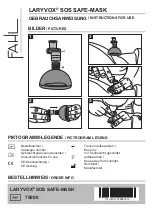
Breaker close/trip circuit monitoring
TCSSCBR
The trip circuit monitoring function TCSSCBR is
designed for supervision of control circuits. A
fault in a control circuit is detected by using a
dedicated output contact that contains the
monitoring functionality.
The function picks up and trips when TCSSCBR
detects a trip circuit failure. The trip time
characteristic for the function is of definite time
(DT) type. The function trips after a predefined
operating time and resets when the fault
disappears.
8. Control
Synchrocheck, energizing check, and
synchronizing SESRSYN (25)
The Synchronizing function allows closing of
asynchronous networks at the correct moment
including the breaker closing time, which
improves the network stability.
Synchrocheck, energizing check, and
synchronizing (SESRSYN, 25) function checks
that the voltages on both sides of the circuit
breaker are in synchronism, or with at least
one side dead to ensure that closing can be
done safely.
SESRSYN (25) function includes a built-in
voltage selection scheme for double bus
arrangements.
Manual closing as well as automatic reclosing
can be checked by the function and can have
different settings.
For systems which are running asynchronous a
synchronizing function is provided. The main
purpose of the synchronizing function is to
provide controlled closing of circuit breakers
when two asynchronous systems are going to
be connected. It is used for slip frequencies
that are larger than those for synchronism
check and lower than a set maximum level for
the synchronizing function.
Autorecloser SMBRREC (79)
The autorecloser (SMBRREC, 79) function
provides high-speed and/or delayed auto-
reclosing for single breaker applications.
Up to five reclosing attempts can be included
by parameter setting.
The autoreclosing function can be configured
to co-operate with a synchronism check
function.
Autorecloser STBRREC (79)
The autoreclosing function provides high-speed
and/or delayed auto-reclosing for single
breaker applications.
Up to five reclosing attempts can be included
by parameter setting. The first attempt can be
single- and/or three phase for single-phase or
multi-phase faults respectively.
Multiple autoreclosing functions are provided
for multi-breaker arrangements. A priority
circuit allows one circuit breaker to close first
and the second will only close if the fault
proved to be transient.
The autoreclosing function can be configured
to co-operate with a synchrocheck function.
Bay control QCBAY
The Bay control QCBAY function is used
together with Local remote and local remote
control functions to handle the selection of the
operator place per bay. QCBAY also provides
blocking functions that can be distributed to
different apparatuses within the bay.
Local remote LOCREM /Local remote
control LOCREMCTRL
The signals from the local HMI or from an
external local/remote switch are applied via the
Breaker protection REQ650 ANSI
1MRK 505 269-BUS -
Product version: 1.1
Issued: April 2011
ABB
21
Содержание Relion REQ650
Страница 1: ...Relion 650 series Breaker protection REQ650 ANSI Product Guide...
Страница 90: ...90...
















































